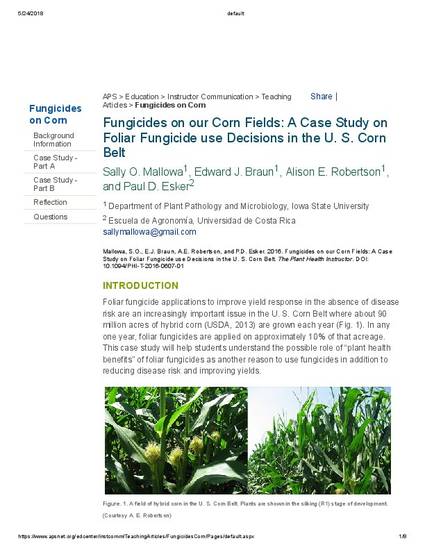
Article
Fungicides on our Corn Fields: A Case Study on Foliar Fungicide use Decisions in the U. S. Corn Belt
The Plant Health Instructor
Document Type
Article
Disciplines
Publication Version
Published Version
Publication Date
1-1-2016
DOI
10.1094/PHI-T-2016-0607-01
Abstract
Foliar fungicide applications to improve yield response in the absence of disease risk are an increasingly important issue in the U. S. Corn Belt where about 90 million acres of hybrid corn (USDA, 2013) are grown each year (Fig. 1). In any one year, foliar fungicides are applied on approximately 10% of that acreage. This case study will help students understand the possible role of “plant health benefits” of foliar fungicides as another reason to use fungicides in addition to reducing disease risk and improving yields.
Copyright Owner
The American Phytopathological Society
Copyright Date
2016
Language
en
File Format
application/pdf
Citation Information
Sally O. Mallowa, Edward J. Braun, Alison E. Robertson and Paul D. Esker. "Fungicides on our Corn Fields: A Case Study on Foliar Fungicide use Decisions in the U. S. Corn Belt" The Plant Health Instructor (2016) Available at: http://works.bepress.com/alison-robertson/265/

Thsi article is published as Mallowa, S.O., E.J. Braun, A.E. Robertson, and P.D. Esker. 2016. Fungicides on our Corn Fields: A Case Study on Foliar Fungicide use Decisions in the U. S. Corn Belt. The Plant Health Instructor. DOI: 10.1094/PHI-T-2016-0607-01. Posted with permission.